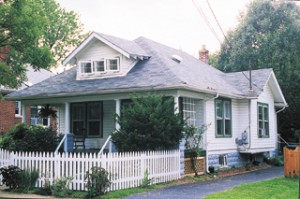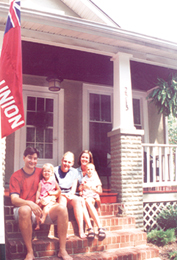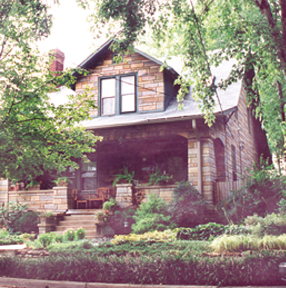by Brian Reid
 Sven Sahkul loves bungalows. When his work commute forced him and his family to move from a Craftsman bungalow near Frederick, Md., he spent nearly a year shopping for a new home outside of Washington, D.C. He finally settled on a Colonial Revival in an up-and-coming Alexandria, Va., neighborhood called Del Ray.
Sven Sahkul loves bungalows. When his work commute forced him and his family to move from a Craftsman bungalow near Frederick, Md., he spent nearly a year shopping for a new home outside of Washington, D.C. He finally settled on a Colonial Revival in an up-and-coming Alexandria, Va., neighborhood called Del Ray.
A neighborhood on the decline 20 years ago, Del Ray has become a magnet for young, urban refugees in the D.C. area who, like Sahkul, are looking for beautiful homes, front porches and backyards. The streets are filled with children: Sahkul has two, and strollers parade up and down the neighborhood avenues on summer evenings.
Sahkul has spent the last two years restoring the house to the look it may have possessed in 1927, when it was built. Gone is what he called a “Brady Bunch” aesthetic when he moved in, replaced with period details. The track lighting has been ripped out, and in its place are period porcelain fixtures from eBay. Even the door hinges are being systematically updated — or, more accurately, retrograded.
 “We like bungalows, and Del Ray is such a cool neighborhood. There are lots of kids and baby strollers,” Sahkul says. And, of course, he’s also drawn to the porches.
“We like bungalows, and Del Ray is such a cool neighborhood. There are lots of kids and baby strollers,” Sahkul says. And, of course, he’s also drawn to the porches.
My own experience with the neighborhood was perhaps typical. My wife, Beth, and I were looking for our first house without much luck. We had an apartment in Old Town Alexandria, a part of the city with centuries-old buildings and a retail strip filled with art galleries and restaurants. We’d spent much of our time looking on the fringes of that neighborhood, seeking out the familiar. The homes we found were overpriced, undersized townhouses with few windows and tiny backyards. We appealed to our agent for more options. She pointed us to Del Ray. “Porches,” Beth whispered to me as we drove the streets of Del Ray for the first time. “These places all have porches.”
A mile from our old apartment, Del Ray begins, and the townhouses give way to an eclectic assortment of bungalows, Foursquares and Queen Annes. Like Sahkul, we wound through the neighborhood looking for the telltale sign of a dream house: a porch swing.
 But interest in Del Ray had exploded with the jump in the Washington area’s population during the 1990s. Houses were listed for mere days, and anxious buyers found themselves in bidding wars that drove prices well above asking prices. We considered it an extraordinary stroke of luck when a contract fell through on a white bungalow along a tree-shaded street, giving us a chance to bid. We were ecstatic. It had a porch swing.
But interest in Del Ray had exploded with the jump in the Washington area’s population during the 1990s. Houses were listed for mere days, and anxious buyers found themselves in bidding wars that drove prices well above asking prices. We considered it an extraordinary stroke of luck when a contract fell through on a white bungalow along a tree-shaded street, giving us a chance to bid. We were ecstatic. It had a porch swing.
A year later, our first child arrived, one of seven born over the course of one year on our block. We appeared to have filled the two requirements to be Del Ray parents: a front porch and a stroller on that porch.
The first homes were built in Del Ray at the opening of the 20th century, taking advantage of the neighborhood’s proximity to the nearby rail yards. Within decades, it was a busy suburban hub, drawing not only rail workers who could walk to work, but also those who worked in Washington. Trolleys linked Del Ray to the nation’s capital, allowing a quick commute into the center of the city, only six miles away. Now, a Metro stop sits on one corner of the neighborhood.
Del Ray was originally chartered as a town unto itself and then, as now, had a fierce civic pride. When the city of Alexandria decided to annex it in 1930, forcing the neighborhood to become Alexandria’s satellite, legend holds that Del Ray’s leaders burned all of the town’s records in an act of defiance.
 The area fell on hard times in the 1960s and ’70s, as longtime residents left the neighborhood and crime rates crept up. But the area has witnessed a revival over the last two decades, and the real estate boom of the late 1990s made Del Ray a regional hotspot.
The area fell on hard times in the 1960s and ’70s, as longtime residents left the neighborhood and crime rates crept up. But the area has witnessed a revival over the last two decades, and the real estate boom of the late 1990s made Del Ray a regional hotspot.
The neighborhood’s retail corridor has grown, with the local coffee shop, St. Elmos, serving as the area’s hub. Shops hawking everything from frozen custard to comic books line the neighborhood’s main street and a local arts festival in the fall draws thousands.
The neighborhood has be-come a diverse one of young professionals looking for a respite from busy urban life and blue-collar workers attracted to what were once reasonably priced homes. In that way, the neighborhood has come full circle.
The rebirth has been a boon for builders and architects, who have struggled with the demand for renovated bungalows.
“The last five years have been non-stop,” says Gaver Nichols, an architect who’s focused much of his energy on the local area, completing more than 100 projects within a mile of his own bungalow. “People want character. Smaller can be better. It’s all in the details.”
 David Hudson and his wife live in a bungalow across the street from Sahkul and his family, and he, too, raves about “the coziness, the ambiance you get” in the neighborhood. Hudson passed his future home three or four times while looking to buy — the permastone exterior turned his head away — but his heart led him back, and he’s been a Del Ray citizen for eight years.
David Hudson and his wife live in a bungalow across the street from Sahkul and his family, and he, too, raves about “the coziness, the ambiance you get” in the neighborhood. Hudson passed his future home three or four times while looking to buy — the permastone exterior turned his head away — but his heart led him back, and he’s been a Del Ray citizen for eight years.
A contractor, Hudson was impressed from the moment he walked in the door: the woodwork was original, the trim remained unpainted. Like most of Del Ray’s other bungalow dwellers, he knew there was something magical about the house. “It had good bones,” he says, pausing. “It had soul.”
And Hudson says the same of Del Ray. After nearly a decade, he’s seen a community revitalized. Front lawns are neatly trimmed, the scent of fresh paint tinges the air and residents are packing the new family owned eateries that line Del Ray’s main drag.
The allure for Hudson is powerful, and even after he hangs up his hammer, he’s not likely to flee to the Florida coast. “If we retire on the East Coast, it’ll be here,” he said. “I haven’t seen any other neighborhood like this. There’s no other neighborhood that appeals to me.”
Brian Reid and Beth Burkstrand-Reid live in their Del Ray bungalow with their darling daughter and their faithful dog. Brian, a stay-at-home dad, writes freelance articles on health and medicine, and Beth works as a lawyer.
Pin It


